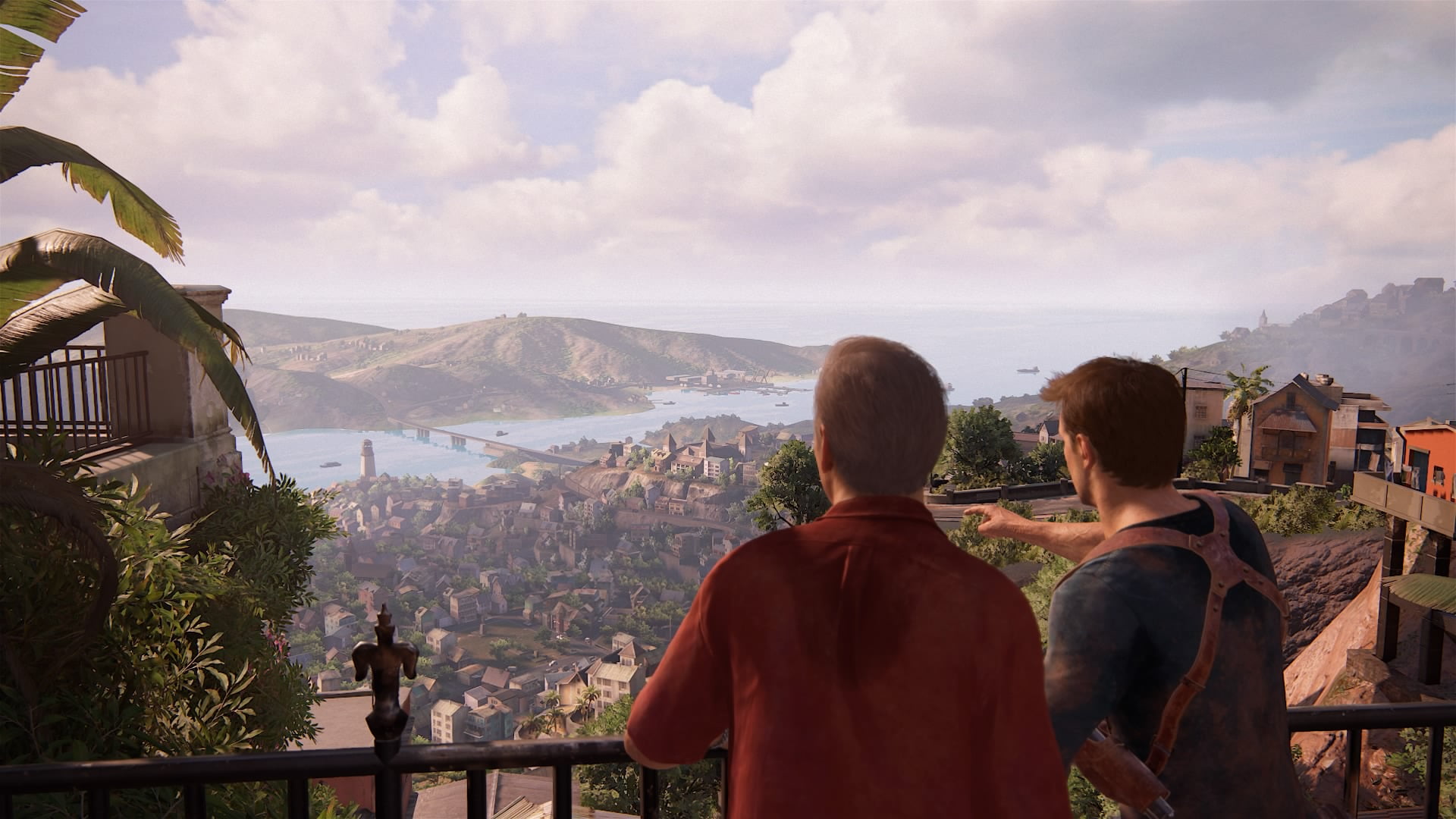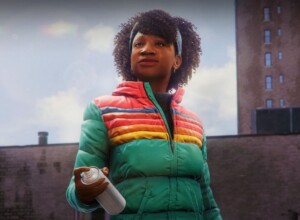Bounding, as if on inlines, down a hallway away from gunfire, you aim toward the only terminus you can see – a shuttered window. Sure enough, as a salvo of bullets give furious chase, you burst from the window in a shower of glass. A blinding light bloom settles into focus as you sail through the air above scorched terracotta. Landing on the opposite roof with an almighty clatter, you stand tall without a scratch. As long as you keep your arms and legs inside the ride at all times you have nothing to worry about.
The Uncharted series has made use of these set-piece thrills, directorially dampening our input to pull together scenes you would watch in Hollywood blockbusters. Whether that means putting the wind at your back to further a jump, buffing you on track with an invisible wall, funnelling you through ‘scenes’, plugging up the gutter lanes. Last year the series’ cinematic aspirations truly hit peak with its fourth entry, Uncharted 4: A Thief’s End.
Here was a game with a desire to spit in the face of the gods. The motion capture of Uncharted 4 lacked the uncanny mannequin clank of L.A. Noire, opting for expressive warmth and humanity – keeping step with a script penned with pathos and levity. It was formidable. It squeezed fresh blood from the series’ formula, airlifting in the shooting and stealth from The Last of Us, and showcasing the most beautiful graphics ever seen on a console. It delivered an experience filled with the bombast and budget of the swaggering action-adventure films it aspired to.
And yet… the plight of the reflection is that it cannot break free of the mirror. Uncharted 4 managed the best imitation of Hollywood that any game has, but it’s caught with one foot on either side of a chasm. On the one side you have the world of play, its stories pushed back to the breaks in the game. On the other, you have films, a world of uninterrupted surrender. Uncharted straddles the divide by doing just that: straddling it. Stretches of beautiful CG cinema break up stretches of play. What’s in those scenes, and what’s in those set-piece shoot-outs is the stuff of the silver screen. But there stands a partition between these two charted worlds.

Marshall McLuhan wrote “The medium is the message”, meaning the form of mediums like film, games, or television becomes what is communicated. The crux of it, McLuhan surmises, is that the “content of any medium is always another medium.” So for instance, Speech is the content of writing; writing is the content of print; print is the content of the newspaper – but these things transform into new messages when put through the machinery of a different medium.
McLuhan explains that film transformed “the world of sequence and connections into the world of creative configuration and structure.” We, as viewers, come to understand the language of film. Camera cuts symbolise transition, journey; whereas in life, there are no cuts. Though film depicts life, the form of the medium transfigures it into a new creature, a new message.
Video games do the exact same thing. The content of video games is pulled from lots of other mediums – writing, sculpture, architecture, music, and most often, film. Video games re-craft and repurpose these into a new message; this is why trying to craft ‘cinematic games’ can feel strained. In effect it reverses the process. Uncharted’s folly is to take the content of film but to fall back on the video game medium; it has filmic cut-scenes and great motion-capture and Michael Bay set-pieces. In-between these you play a game.
There is a better way. If you aspire to cinema, then you can aspire to the medium, and not the content of the medium. Don’t go for the things in the film; go for the way they are constructed.
There was a game released last year, four months after A Thief’s End, called Virginia. Developed by a tiny independent studio called Variable State, Virginia quietly capitalised on a cinematic quality which video games hadn’t yet reached. It took up the torch from Thirty Flights of Loving and pushed it forward with aesthetic purpose. If the goal was to distil the feeling of playing through a film, then it quietly outperformed Uncharted 4, with a speck of the budget.
Virginia looked lovingly to the medium of film instead of its content. It took the signature tool from the form of film, the cut, and stitched it into the fabric of play. Juxtaposing scenes, it smashed together images and forged connections as you played through it. Walking down a hall became descending the stair become reaching a door. The content of video games – traversal, exploration, play – was sliced and edited with filmic form, into the language of “creative configurations and structure” as McLuhan called it.
This alone would have been gimmick, but it brought with it a new visual language, an imagination to its world utterly unique. To Play Virginia is to dive into a heady decoction of the real and the illusory, of the abstract and the immediate. The camera cut is at the heart of its cinematic power and is how it achieves its elusive ability to communicate the intangible.

It leans on content as well: it’s a riffle shuffle of calling cards picked from iconic TV and film. It isn’t just that we are familiar with these spaces – diners from Twin Peaks, FBI offices from The X-Files – it’s that as we play we move through them like screens in a gallery. Virginia captured the feeling of watching these shows; it pulled us into not just their worlds, but their creative configurations, their structures.
Pauline Kael, in her review of Jean-Luc Godard’s Bande à part, wrote about the way that Godard built his aesthetic. She describes Bande à part as being “like a reverie of a gangster movie as students in an expresso (sic) bar might remember it or plan it.” This is how Virginia feels as well. The camera cut used in Virginia not only aspires to a cinematic quality that works in tandem with the medium of video games, but uses it to create a new aesthetic.
Kael continues, “It’s as if a French poet took an ordinary banal American crime novel and told it to us in terms of the romance and beauty he read between the lines; that is to say, Godard gives it his imagination, recreating the gangsters and the moll with his world of associations.” And that’s where you are when you play Virginia. You are in a world of associations, and play is the thing between the lines. It’s like staring through a set of Venetian blinds, the light between the slats licking across your eyes.
It also beckons you into its world without a word of dialogue; you read the faces of characters to navigate interactions. This silence has an oddly cinematic effect: it directs your attention inward, as though you are inside someone’s head in a film, moving yourself, exploring in that skull-sized kingdom. You are both within characters, thinking as they might, but quietly within your own mind as well. You inhabit characters in the same active surrender you do at the movies.
What you end up with is the most successful attempt at grounded surrealism in gaming yet made, and a game that feels cinematic to play. If you want to be cinematic in the way that you create games, you shouldn’t copy films. You should copy film.







Interesting and inevitable however saying the medium isn’t the message is like saying ‘this sentence is false’ it’s always true and unavoidable
That’s interesting; I don’t quite follow though. How do you mean?